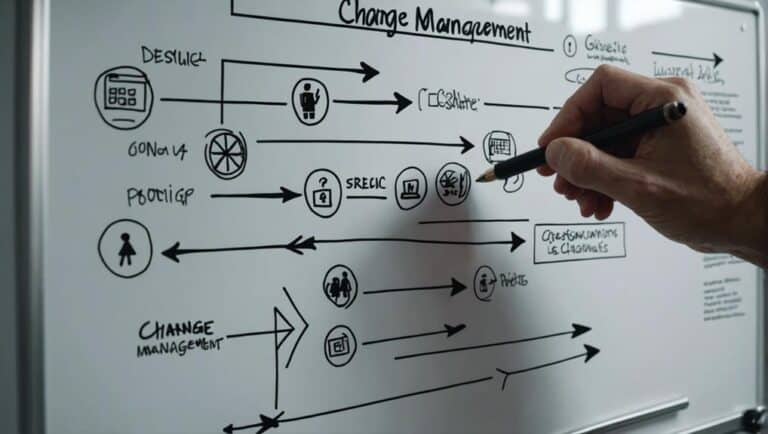Ready or not, change happens to all organisations at some point. IT can be caused by internal or external factors, and those who learn to manage change will often come out on top. So what role do managers play, and how can they support change to ensure success?
Managers support change by playing five critical roles: communicator, liaison, resistance manager, advocate, and coach. They need to take on these roles to aid the adoption of change for themselves and their teams.
Managers can be the make or break point during the change management process. Their ability to lead their teams through the transition often decides whether the process will fail or succeed.
As such, what are the roles a manager must take on to ensure transitions are smoother and better adopted by individual employees?
Let’s walk through the roles of managers during change and how the process can support this role.
5 Key Roles of Managers During Change
Managers hold immense influence over individual employees in a team. They are actively involved in implementing the change and managing employee feedback. They must be properly onboarded and given adequate resources to drive change.
Prosci’s research shows that there are five key roles a manager must play during a transition period:
- Communicate the need for change
- Collaborate between different departments
- Support the change by being an active advocate
- Manage resistance through proper tactics
- Train and coach employees to aid adaption

Communicator
Communication is one of the most important aspects of the change management process. Lack of knowledge is the leading cause for change initiatives’ failure. Change management teams within an organization must ensure that all employees have the necessary information to adopt transition.
Managers are vital in this case as they will communicate the need for change to their teams. They must clearly explain why the change is necessary and how it will benefit them and the organization. They must have all the information at hand to put employees’ anxiety at ease and minimize resistance.
Liaison
Managers bridge the gap between the change team and the implementation team. They are responsible for updating the change team on the progress and milestone status during the process. They take feedback from both parties and relay it properly.
At the same time, they also have to provide input when the implementation plan is being designed. Without their knowledge, the project will suffer from the lack of true technical and employee capacity knowledge.
Sustainable change is only possible when the manager reinforces the message over time and keeps communication open between teams.
Advocate
Managers are viewed by their employees as credible sources. They’re influential and respected. This is why managers can be a deciding factor in ensuring the success of a transition. Managers need to support change through their words and actions, so employees can see them as role models and do the same.
Unless they embrace change entirely and show it through their actions, they cannot expect the same from their employees.
Resistance Manager
Resistance is a natural part of the change management process. People always resist the unknown. Managers need to be able to manage resistance tactfully. They need to be patient enough to determine the root cause of the resistance and address it accordingly.
If left unchecked, resistance can evolve into outright denial, contributing to the process’s failure. This is a critical role in aiding the adoption of the change for the employees and minimizing the chances of failure.
See: The Fear of Change: Why Is It So Hard For People And Companies To Accept Change?
Coach
Change is new for the employees, and they will need help navigating through it. Managers must provide staff with the knowledge and resources to adopt change with ease. This is even more important in cases where the changes affect daily work life and task management.
Managers are the best option for the training role since they know each employee in their team at a personal level. Hence, they’re able to coach each employee one-on-one based on individual needs.
This way, you can ensure that all employees in the organization are fully onboard with the transition and have the tools and resources necessary to adopt it.
Leading Through Change with The ADKAR Model
ADKAR is a change management model designed to implement change at the individual level rather than the organizational level. Even if changes are implemented at the organizational level. The real transition happens at the individual level, and this model is an excellent resource for managers trying to lead through the transition.
ADKAR is an acronym for all the steps involved in the process. Let’s look at these in detail below:
A – Awareness
Every employee should understand the need for change. Knowing the change and why it is necessary will motivate the employees. Without this knowledge, employees may feel lost and confused and deny change.
The awareness stage is important in communicating the end goal of the process as well. When employees know what they’re working to achieve, they are more energetic and dedicated to the process.
D – Desire
This stage involves creating a want for change within the employees, but how will you do that exactly? You can’t tell people how to feel. There are different reasons why people may resist change, and lack of engagement is one. The worst thing you can do is invite ideas from employees and never follow up on them later.
Employees tend to accept change much more easily when they are heard and listened to. Transitions are an overwhelming time for your employees, and having the ability to vent makes it considerably easier for them.
So, to create a desire for change, you must help them feel engaged and valued during the process. You must show them what’s in it for them – this can be career advancement, learning, or even increased job security.
K – Knowledge
To embrace the change, employees have to learn new ways of doing certain things and undergo some training as well. This step involves two types of knowledge
- Knowing what they need to do during the change
- Knowing what skills they need to survive after the change is in place
It is important to remember that this knowledge will only be useful when employees have the awareness and desire for change. This knowledge can be imparted using different methods like providing training and certifications.
A – Ability
The knowledge stage is theoretical, and it’s about knowing what needs to be done, but the ability stage is practical and deals with the “how.”
Managers must be extremely attentive to their employees and their feedback during this stage to ensure they pick up on potential barriers and reasons why people aren’t able to adopt the changes.
As a leader, your job is to provide your people with the necessary resources to help them transition easily. The other important factor is encouraging them to believe in themselves and their ability.
R – Reinforcement
Once the change has been fully implemented, the next goal is to reinforce it within each employee. You don’t want to go through the entire process just to end up with employees that slowly revert back to doing things the old way. In order to make change sustainable, you can take the following steps:
- Identifying lapses and reacting immediately
- Positive feedback and reinforcement
- Rewards and incentives for good work
Communication plays a vital role here as well. The key to keeping change alive is to keep talking about it. You need to give enough time for change to be reinforced before you jump onto the next step or transition.
Here is a summary of the roles and responsibilities involved at each stage of the ADKAR model.
| Stage | Roles | Responsibilities |
| Awareness | Line managers, business leaders and sponsors | Communication, 1 to 1 sessions, coaching, and storytelling |
| Desire | Project team, business leaders, line managers, sponsors | Incentivization, resistance management, coaching |
| Knowledge | Project team, HR | Coaching, training |
| Ability | Project team, HR, Line manager | Feedback, coaching, providing tools and facilities |
| Reinforcement | Business leaders, line manager | Rewards, celebrations, corrective measures, positive feedback and reinforcement |
Advantages and Disadvantages of the ADKAR Model
The ADKAR model is focused specifically on individuals and their contribution to change within an organization. It recognizes the need for molding individual behaviors to achieve organizational success.
Now that we are familiar with how to use the ADKAR model to introduce change, let’s look at what are the advantages and disadvantages of using this model:
| Advantages | Disadvantages |
| ADKAR focuses on outcomes rather than tasks | Ignores the need for creating a long-term strategy |
| Each step’s progress is measurable | Ignores the complexities of the change management process |
| The model is people-centric as opposed to organization-centric | Suitable only for small scale changes |
| Clear checklist of steps that need to be achieved |
4 Tips for Leading Change As a Manager
Leading change is hard. It’s even harder when you are the leader of your team, and it can be downright impossible if you don’t have any experience in leading people through change.
But there are four things that will help you lead change effectively.
Embrace the Change Yourself First
Managers have an uphill task ahead of them during a transitionary period. The business leadership and change team have high expectations from them, including
- Communicating change to employees effectively
- Managing resistance tactfully
- Answering questions and reducing anxiety
- Training and coaching employees to help them adapt better
- Keeping employees and the change team updated
Employees will look up to you and keenly observe your behavior to see how you respond to and embrace the change. Demonstrate behavior you want them to replicate to encourage them from the very start.
Make Communication Your First Priority
Effective communication is the most vital pillar of the change management process. The lack of it can lead the best implementation plans to fail quickly. As a line manager, you need to be open about the change with your employees. You need to share the change and why it is necessary for the organization and its benefit.

At the same time, you also need to be equally open about any employee feedback with the management. Your team has to implement the change, and if they have real and valid concerns about anything, you must bring them up to the management.
Invest in Learning
Line managers need a considerable amount of coaching themselves before they can adopt the role of a trainer. We often forget that they go through the change before communicating it to the employees.
The best practice is to invest in training your managers. They need to know the best practices and methods to help them achieve their transitional goals.
Focus on Individuals
Change happens at the individual level. It’s people that drive it. As a manager, you are close to each person in your team. You know how each of them reacts to different kinds of situations.
Holding 1-1 meetings and listening to individual concerns can help you understand the barriers to change and what you need to do to help each individual navigate the transition successfully.
Frequently Asked Questions
How can line managers support change in an organization?
Line managers can induce a positive response from employees by showing how much they care about the impact of the change on the team. They can mobilize individual team members by closely studying and identifying resistant behavior and curbing it initially.
What are the four leading roles of a supervisor during change?
Management, development, support, and mediation are the four main roles a supervisor performs during times of change. They are responsible for ensuring their teams adapt to change with minimal resistance. They also reinforce a sustainable change.
What is the difference between a manager and a supervisor?
Managers have a more holistic focus externally. They look outside the unit as well. Whereas the supervisor has more internal focus, their goal is their internal team and implementing the manager’s directives.
Final Thoughts
A manager’s support of change within a company is incredibly important to the success of that change. A manager must be able to communicate effectively with their team, provide adequate resources and training, and monitor progress throughout the implementation process.
Additionally, it is important for managers to reinforce positive behavior related to the change initiative and give employees frequent feedback. By taking these steps, managers can ensure that changes are successfully implemented within their organizations.
Managers are a crucial part of an organization and even more vital to the change management process. They are at the heart of the change and hold great influence amongst employees. If you want to ensure success for your organization during transitions, you should invest in your managers through the above-mentioned strategies.
Sources
https://www.prosci.com/blog/5-key-roles-for-people-managers-in-leading-change





